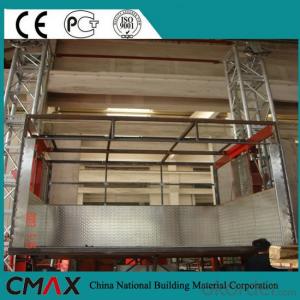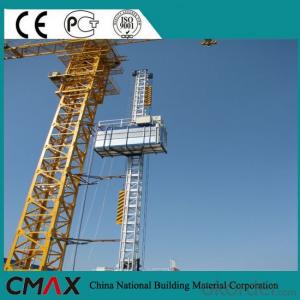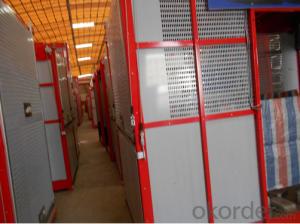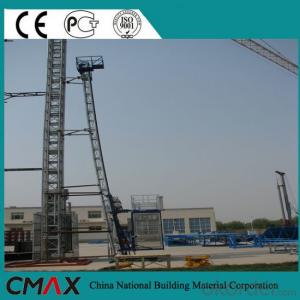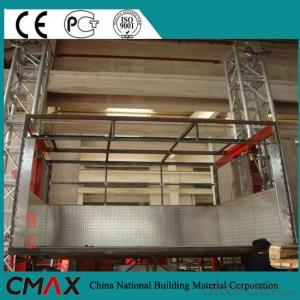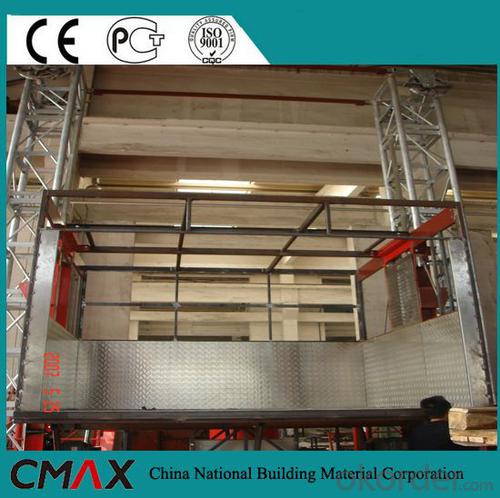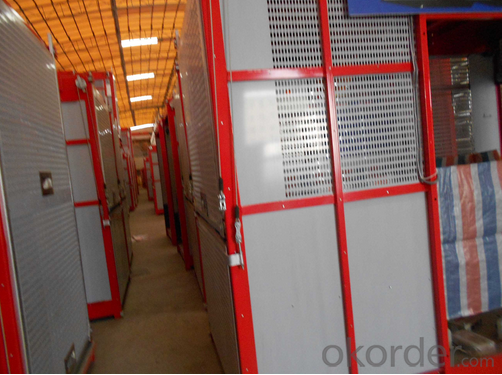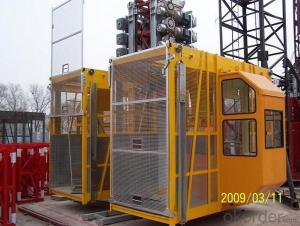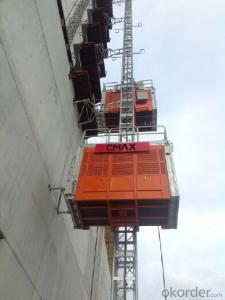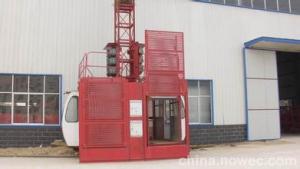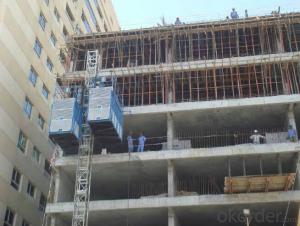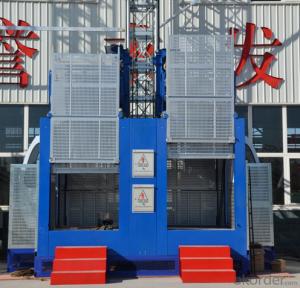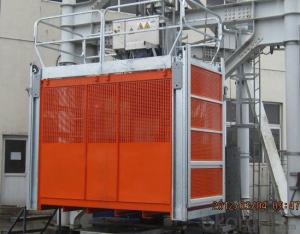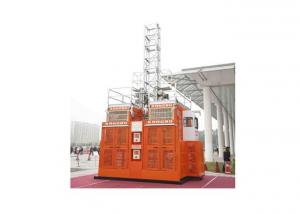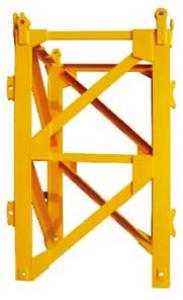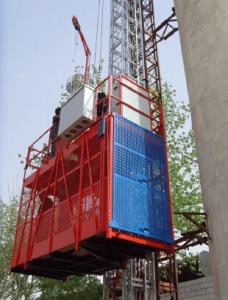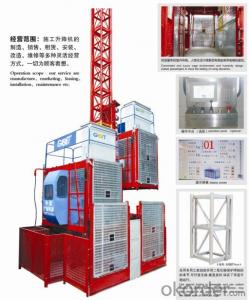Construction Hoist with Mast Section for Building /Chimney/Bridg
- Loading Port:
- China main port
- Payment Terms:
- TT OR LC
- Min Order Qty:
- 1 set
- Supply Capability:
- 1000 set/month
OKorder Service Pledge
OKorder Financial Service
You Might Also Like
Structure of Construction Hoist with Mast Section and Rack for Building /Chimney/Bridge
1). Cage load capacity: 2, 000kg
2). Lifting speed: 36m/min, 0 - 63m/min, 0 - 96m/min
3). Mast section: Painted or hot dipped zinc
4). Cage: Single cage or twin cage
5). Recommended cage inner dimensions (L x W x H): 2.5 x1.3 x 2.5m, 3.0 x 1.3 x 2.5m, 3.2 x 1.5 x 2.5m, 3.6 x 1.5 x 2.5m, 3.8 x 1.5 x 2.5m, 4.0 x 1.5 x 2.5m, 4.2 x 1.5 x 2.5m, according to requirements of customers
6). Motor and reducing device: Made in China, or uses SEW according to requirements
7). Counterweight: With counterweight or without counterweight
8). Color of cage: Yellow, red, blue
9). Cage load capacity: 1, 200kg, 2, 000kg, 2, 700kg or 3, 200kg
Construction Hoist with Mast Section and Rack for Building /Chimney/Bridge Specifiction
The newly designed computer controlled auto landing equipment, wireless floor call system and the overload alarming caller can be chosed by customers. The above three functions can be used alone or together according to the requirement of customers. The computer controlled auto landing equipment, wireless floor call and the overload alarming caller can be one computer controlling panel to realize the automatic operating.
| Model(single and double cage) | Capacity(kgs) | Lifting speed(m/min) | Motor power(kw) |
| SC100TD | 1000 | 36 | 2x11 |
| SC200TD | 2000 | 36 | 3x11 |
| SC270TD | 2700 | 36 | 3x15 |
| SC320TD | 3200 | 36 | 3x18.5 |
| SC100/100TD | 2x1000 | 36 | 2x2x11 |
| SC200/200TD | 2x2000 | 36 | 2x3x11 |
| SC270/270TD | 2x2700 | 36 | 2x3x15 |
| SC320/320TD | 2x3200 | 36 | 2x3x18.5 |
| SC100GZ | 1000 | 0-63 | 2x15 |
| SC200GZ | 2000 | 0-63 | 3x18.5 |
| SC270GZ | 2700 | 0-63 | 3x22 |
| SC200/200GZ | 2x2000 | 0-63 | 2x3x15 |
| SC270/270GZ | 2x2700 | 0-63 | 2x3x18.5 |
| SC320/320GZ | 2x3200 | 0-63 | 2x3x22 |
| SC100/100G | 2x1000 | 0-96 | 2x2x22 |
| SC200/200G | 2x2000 | 0-96 | 2x2x22 |
| SC270/270G | 2x2700 | 0-96 | 2x2x22 |
Construction Hoist with Mast Section and Rack for Building /Chimney/Bridge Images
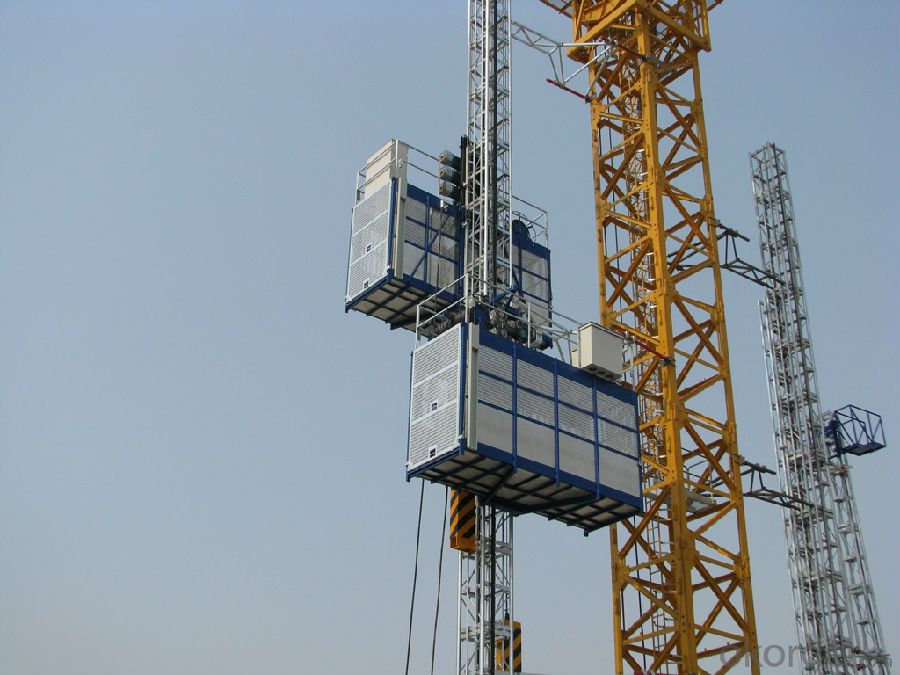
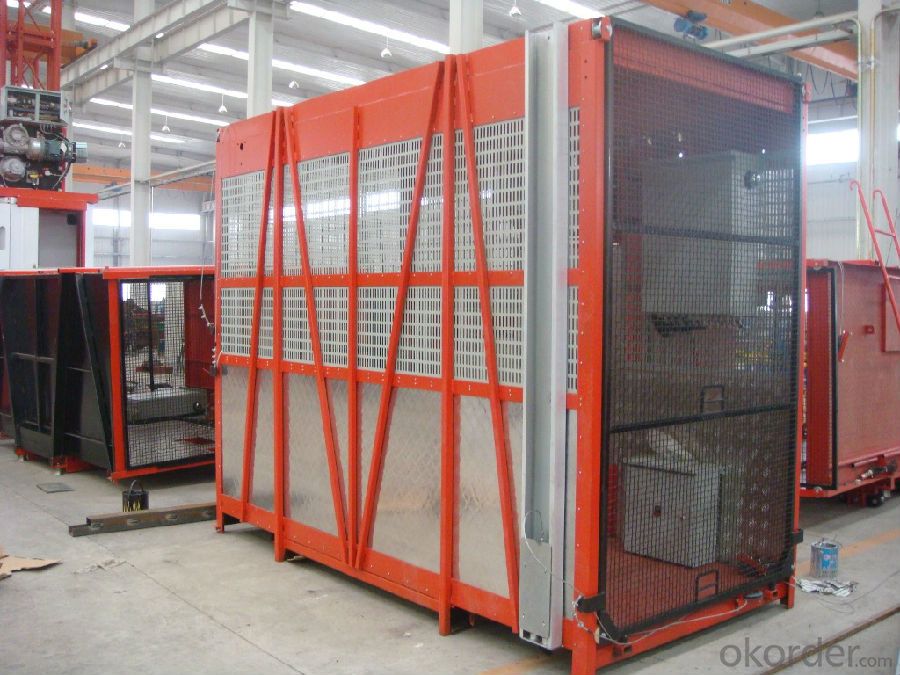
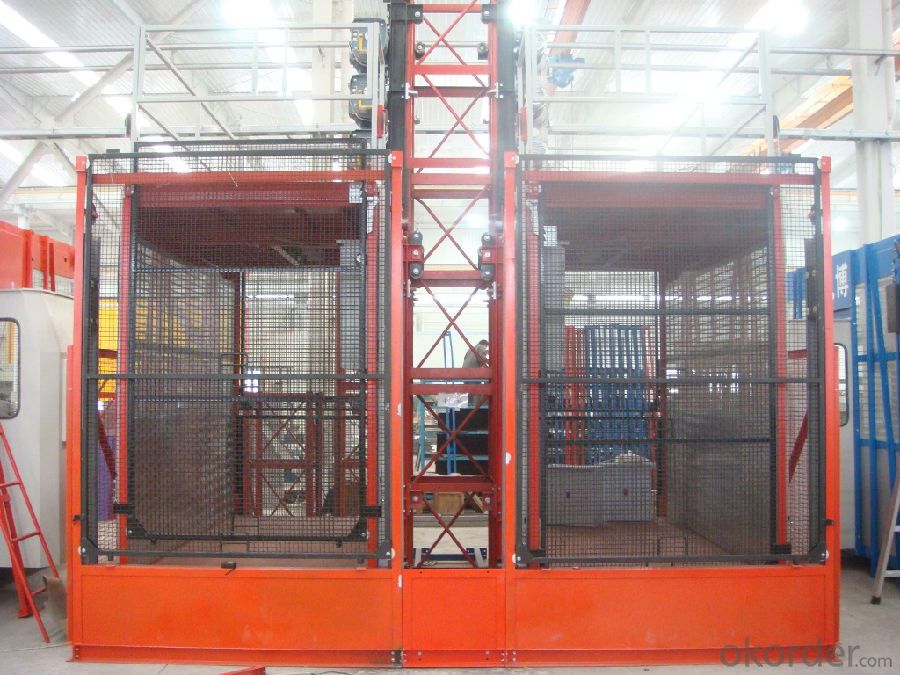
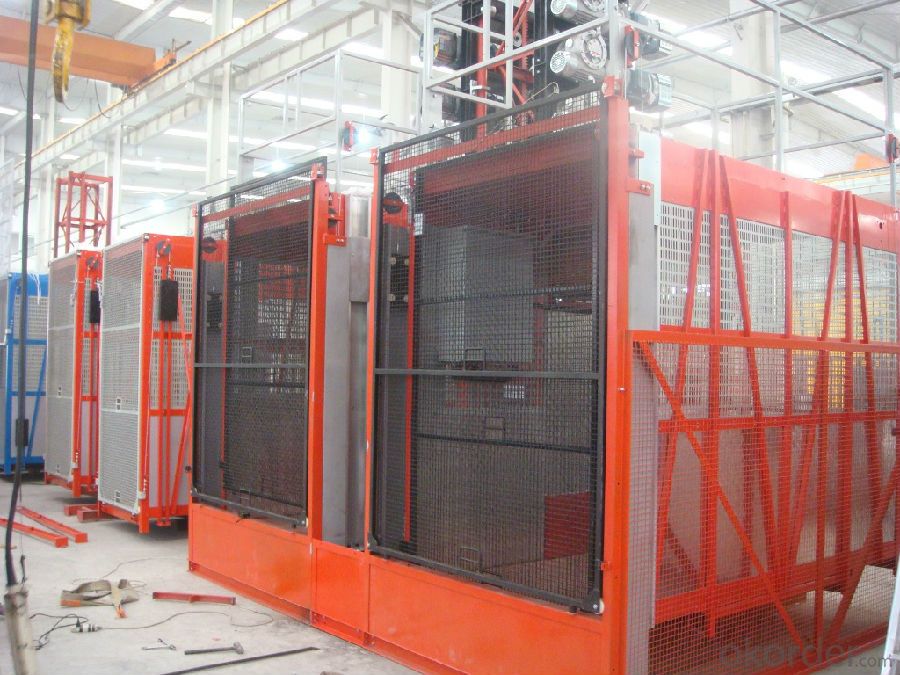
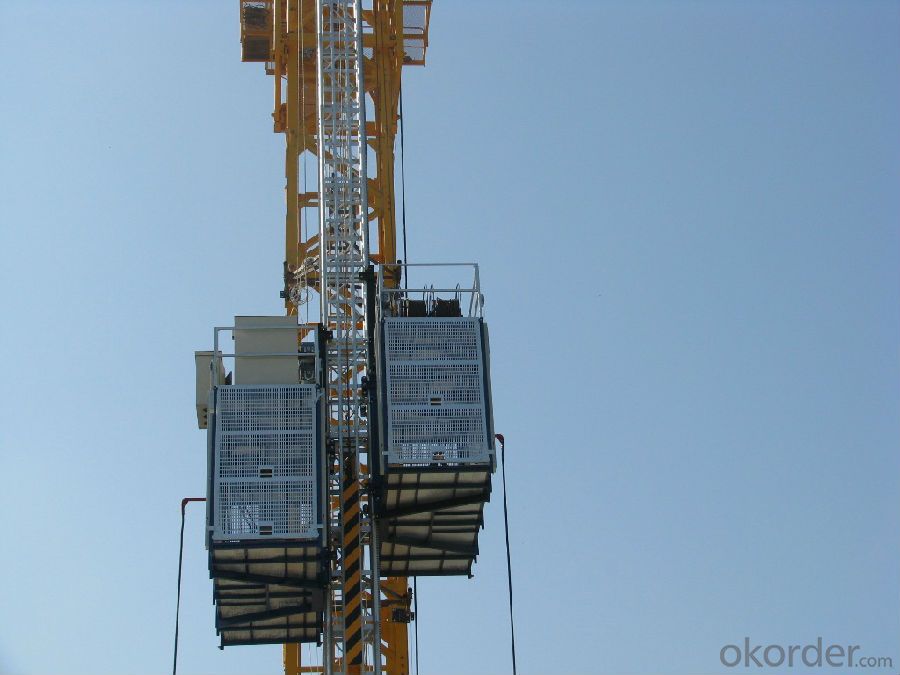
FAQ of Construction Hoist with Mast Section and Rack for Building /Chimney/Bridge
Q: What is the building hoist main purpose?
A: Building hoist equipped with double or single cabin to transport the materials and labors up and down. It's the ideal
construction equipment for vertical transportation in the field of construction.
Q: What is the main structure of building hoist?
A: The P/M construction hoist mainly contains metal structure, driving system, electrical control system, cable guide &
protection system, electrical top crane and safety device.
Q: What is the meaning of the building hoist’s code?
A: Take SC200/200 for example: “SC” stands for rack and pinion hoist, “200/200” stands for double cage and capacity
is 2 tons per cage. “SC200” stands for single cage and capacity is 2 tons.
Q: What is the dimension of the cage?
A: Normally the cage dimension is 3X1.5X2.5M (L/W/H) for 2t type hoist. Details should be checked according to our
quotation sheet. Also, the size can be customized according to the factual site condition. There are two doors (entrance
& exit doors) for each cage, It can be produced as up & down sliding or ramping model for safety and convenience
- Q: This question asks about the typical issues encountered with lifting devices and seeks advice on how to prevent these problems.
- <p>Common problems with lifting devices include mechanical failure, overloading, improper use, and lack of maintenance. To avoid these issues, ensure regular inspections and maintenance, follow the manufacturer's guidelines for weight limits, and train operators on proper use. Additionally, implement safety protocols, such as load testing and visual inspections before each use, and consider using lifting devices with safety features like overload protection and limit switches.</p>
- Q: This question asks whether a building hoist can develop operational issues due to incorrect usage or lack of maintenance.
- <p>Yes, a building hoist can malfunction due to improper use or inadequate maintenance. Improper use may include overloading the hoist, using it in unsuitable conditions, or operating it without proper training. Inadequate maintenance can lead to wear and tear, lubrication issues, and component failures. Regular inspections, proper usage guidelines, and timely repairs are crucial to prevent malfunctions and ensure the safety of the hoist and its operators.</p>
- Q: Is it possible to fix a building hoist or substitute it with alternative lifting machinery?
- <p>Yes, a building hoist can be repaired if the damage is not severe. If repair is not feasible or cost-effective, it can be replaced by other types of lifting equipment. There are various alternatives available, such as cranes, forklifts, and material hoists, each with its own advantages and suitable for different scenarios. The choice depends on factors like the weight of the load, the height of the building, and the specific requirements of the construction project. It's essential to consider safety, efficiency, and compatibility with the existing infrastructure when making such decisions.</p>
- Q: What are the pros and cons of utilizing hydraulic fluid within the system of a building hoist?
- <p>The advantages of using hydraulic fluid in a building hoist include smooth and controlled lifting, which reduces the risk of accidents. It also offers a compact design due to the high power-to-weight ratio of hydraulic systems. Additionally, hydraulic systems are known for their durability and low maintenance requirements. However, there are disadvantages such as the potential for leaks, which can be hazardous and costly to repair. The systems can also be sensitive to temperature changes, which might affect performance. Lastly, hydraulic fluids can be environmentally harmful if not properly managed, posing disposal challenges.</p>
- Q: What are the necessary conditions and safety measures to be met when using a building hoist to lift heavy objects?
- <p>Lifting heavy objects with a building hoist requires adherence to several key requirements for safety and efficiency. These include ensuring the hoist is properly installed and inspected, the load is secured correctly, and the weight does not exceed the hoist's capacity. Operators must be trained and certified, and they should follow all safety protocols. The area around the hoist should be clear of obstructions and bystanders. Regular maintenance and checks are crucial to prevent accidents. Additionally, weather conditions, such as high winds, can affect the safety of hoist operations and may require postponing lifts until conditions improve.</p>
- Q: This question asks about the typical issues encountered with building hoists and the methods to address these problems.
- <p>Common faults in building hoists include mechanical failures such as worn gears or chains, electrical issues like short circuits or malfunctioning controls, and structural problems such as misaligned guides or damaged safety devices. To deal with these issues, regular maintenance and inspection are crucial. Mechanical faults can often be resolved by replacing worn parts or lubricating moving components. Electrical problems may require a thorough check of wiring and control systems, possibly involving a qualified electrician. Structural issues might necessitate adjustments or repairs to ensure the hoist operates safely. In all cases, following the manufacturer's guidelines and safety protocols is essential to prevent accidents and ensure the hoist's reliable operation.</p>
- Q: This question asks for safety guidelines and procedures to be followed when operating a building hoist.
- <p>To use a building hoist safely, follow these guidelines: Ensure the hoist is regularly inspected and maintained by qualified personnel. Never exceed the hoist's load capacity. Keep the hoist and its surroundings clean and free from debris. Always use safety hooks and never leave the hoist unattended when in use. Ensure all safety features, such as limit switches and emergency stop buttons, are functioning correctly. Train operators on the proper use of the hoist and adhere to all manufacturer's instructions. Never use a hoist if it shows signs of damage or malfunction. Always wear appropriate personal protective equipment (PPE) when operating a hoist.</p>
- Q: This question asks about the procedures and methods for maintaining and repairing a building hoist, which is a type of lifting equipment used in construction.
- <p>To maintain and repair a building hoist, follow these steps: Regularly inspect the hoist for any signs of wear and tear or malfunction. Lubricate moving parts as per the manufacturer's recommendations to reduce friction and prevent rust. Check and replace worn cables, pulleys, and other components. Ensure that safety devices like limit switches and emergency stops are functioning correctly. For repairs, address any mechanical failures, replace broken parts, and make sure the electrical system is in good condition. Always follow the manufacturer's guidelines and consult with a professional if the issue is complex or beyond your expertise. Regular maintenance and prompt repairs can extend the life of the hoist and ensure safe operation.</p>
- Q: This question asks about the various types of control systems used in building hoists, which are essential for the safe and efficient operation of construction elevators.
- <p>There are several types of building hoist control systems that ensure the safe and efficient operation of construction elevators. These include: 1. Manual Control Systems: Operated by a human operator who controls the hoist's movement. 2. Semi-Automatic Control Systems: Combine manual operation with some automated features, like automatic level selection. 3. Fully Automatic Control Systems: Completely automated, with the hoist moving between floors without manual intervention. 4. Microprocessor-Based Control Systems: Utilize advanced microprocessors for precise control and monitoring. 5. PLC-Based Control Systems: Use Programmable Logic Controllers for robust and customizable control. 6. Wireless Control Systems: Enable remote operation and monitoring of the hoist. Each system has its advantages and is chosen based on specific project requirements, safety standards, and budget considerations.</p>
- Q: This question asks for guidelines on the safe operation of a building hoist, a device used to lift materials in construction.
- <p>To use a building hoist safely, follow these guidelines: Ensure the hoist is properly installed and inspected by a qualified person. Never exceed the hoist's weight limit. Keep the hoist area clear of obstacles and ensure all safety devices are functioning. Do not use the hoist if there are any visible defects or damage. Always secure the load properly and ensure it is balanced. Never leave the hoist unattended while in operation. Use hand signals or a communication system to coordinate with the operator. Regularly inspect and maintain the hoist to prevent accidents. Always follow the manufacturer's instructions and adhere to local safety regulations.</p>
Send your message to us
Construction Hoist with Mast Section for Building /Chimney/Bridg
- Loading Port:
- China main port
- Payment Terms:
- TT OR LC
- Min Order Qty:
- 1 set
- Supply Capability:
- 1000 set/month
OKorder Service Pledge
OKorder Financial Service
Similar products
Hot products
Hot Searches
Related keywords
